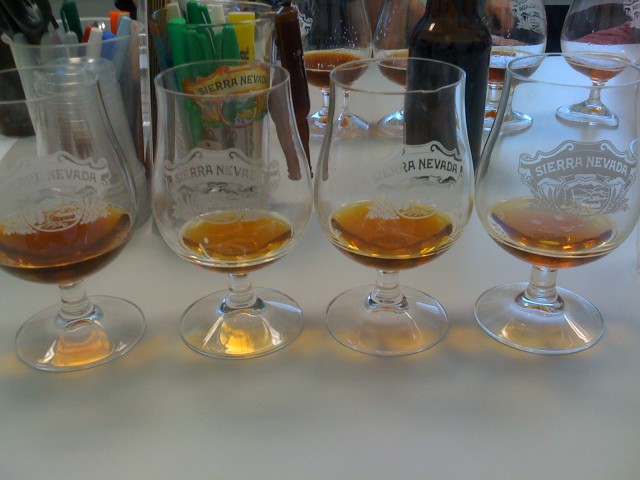
Beer Camp… What a concept. Sierra Nevada Brewery launched “Beer Camp” in May 2008. The idea was to invite key accounts to Northern California for an in depth look at the brewery, exposing participants to the beer, philosophy and culture of Sierra Nevada. The culmination of the two-day experience is a chance to create and brew a beer on the brewery’s 10 barrel pilot system.
Over time, the type of participant has expanded to include brewers such as Tomme Arthur of Lost Abbey/Port and beer media types such as Rick Sellers of Draft magazine and ourselves.
As huge fans of Sierra Nevada, Beer Camp was something we really wanted to do. Our local Sierra rep, Quinn, had been trying to get us scheduled since last fall but the dates never worked for us. We were either traveling or the dates too closely surrounded a trip. Finally, the June 2009 dates matched our schedule and last week we headed to Chico.

Beer camp #8 began bright and early on Thursday morning… 8am to be exact. Meeting in a conference room lovingly referred to as the “fish bowl”, we met our fellow campers for the first time. Our group of eight was probably pretty typical of other beer camps; two were involved in retail while the other four had bars or pubs. Our host was Steve Grossman, Brewery Ambassador and brother of brewery founder Ken Grossman.
After a Sierra Nevada history lesson, it was time to put on the safety glasses in preparation for a comprehensive tour of the Sierra Nevada facility. Sierra Nevada Brewer Terrence Sullivan walked and biked us all over the sprawling maze-like facility. I think we saw pretty much everything: grain storage, grist mill, hop storage, brew kettles, tasting labs, fermentation rooms, and the bottling line. The only thing we missed was the POS storage, but stacks of beer coasters didn’t sound too exciting anyway.
We also got to view Sierra’s array of solar panels, the second largest private installation in the country. With their solar panels and fuel cells, Sierra Nevada is producing 90%+ of their own power and has even returned power to the grid several times in the last few months.

My favorite part of Day One was our visit to the sensory lab. To help us better understand the different flavors that can be present in beer, we had a vertical tasting of Sierra Nevada’s Bigfoot Barleywine. We sampled four different Bigfoot years: 2000, 2003, 2006 and 2009. Staring with the hoppy 2009, we tasted down the years with each presenting a different set of taste sensations. 2003 was the expected prunes and raisins, but that flavor gave way to strong cherry overtones in the 2000.
The most important task of Day One was to choose the beer we were going to brew on Day Two. Right after sampling the Bigfoot vertical, we retired to our conference room to hash it out. We were threatened with a quiz if we couldn’t come to a consensus. The person with the highest score would get to decide what beer to brew. None of us had any strong feelings on what beer to make. A Double IPA was suggested, as well as, a malt liquor (I think Dave was joking, but I’m not positive). In the end, it was Steve Grossman who suggested we do a California Common and the group quickly embraced the idea. Fermenting a lager beer at ale temperatures had never been done at Sierra Nevada and we all liked the idea of making history.
It was also quickly decided that our California Common wasn’t going to be like the one from San Francisco. It was not only going to have a higher ABV, but also be aggressively hopped. At this point, Merideth made her brilliant contribution to our brew, the name: Nuthin’ in Common.

All that remained was to hash out the ingredients with Scott Jennings, the pilot brewery’s head brewer. We talked about the types of malts and hops we wanted to use. I think only three of our group had homebrewed before and none of us had formulated a beer recipe. Scott deftly pointed us in the right direction. Wanting a deep amber color, he suggested a combination of malts that would achieve our desired hue. Being much more interested in the hops, we made a pilgrimage down to the hop storage to get to know our hops better. The final targets were an ABV of 6.5-7% and the IBUs around 55.

We finished the brewery tour part of our day with a visit to the hop fields that border the eastern end of the property. Recently expanded from three to nine acres, these hops are the cornerstone of the excellent estate beers that Sierra Nevada has been producing for the last few years.
The business end of our day was over. It was off to the Sierra Nevada pub to have a few beers and dinner. The pub was crowded with customers and employees just off work. The previous beer camp’s brew, a smoked beer made with some rye, debuted on cask that afternoon. We made it an early night because the following day was brew day.
